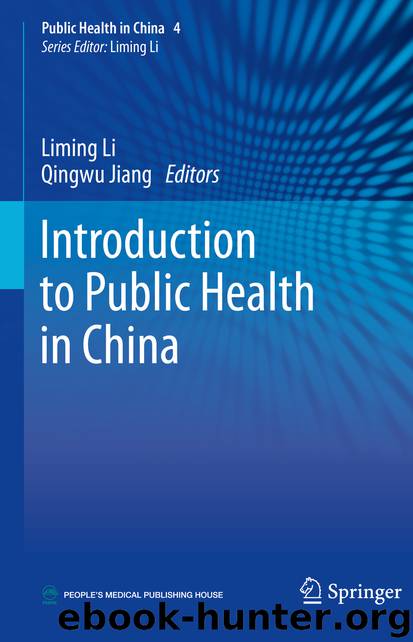Introduction to Public Health in China by Liming Li & Qingwu Jiang

Author:Liming Li & Qingwu Jiang
Language: eng
Format: epub
ISBN: 9789811365454
Publisher: Springer Singapore
Patriotic health campaign was launched right after the founding of the People’s Republic of China in 1949, to address the urban and rural environmental cleanliness and combat the epidemics of infectious diseases that were left by the war and old society. Party organizations and governments at different levels began to launch mass health campaigns. The Government Administration Council (GAC) established the Central Epidemic Prevention Committee in October 1949 due to an outbreak of plague in Chabei district (Northwest Hebei today). In 1952, during the Korean War, the US army used biological weapons, dropping insects, and rodents carrying pathogenic microorganisms in North Korea and border areas of China. In response, in March 1952 the GAC decided to revive the Central Epidemic Prevention Committee. In December of the same year, the committee was renamed the Central Patriotic Health Campaign Committee, with its first head then-Premier Zhou Enlai. In accordance with the requirements from the central government, Patriotic Health Campaign Committees were established at various levels, across different sectors and in all workplaces. These Committees organized residents in both rural and urban areas and staff in workplaces to conduct environmental cleanups, as well as the extermination of disease-carrying pests such as houseflies, mosquitoes, fleas, and rats. Chairman Mao also gave inspiring calling to this movement: “Mobilize everybody to pay attention to personal hygiene, to reduce diseases and improve people’s health, to smash the enemy’s bacteriological warfare to pieces.” Subsequently, patriotic health campaigns went into full swing across the country. In August 1998, the State Council decided to rename the Patriotic Health Campaign Committee to the National Patriotic Health Campaign Committee.
The specific context in which the Committee (and its work) emerged means that its name bears strong political connotations. The use of the word “patriotic” in the name of the Committee required the people to place the work of the corresponding health-related efforts on the same level of importance of the nation itself, while the term “health” described the scope of such efforts, and the term “campaign” specified the means of social mobilization.
Following victory in the Korean War, the central Party apparatus and the State Council continued to focus on patriotic health campaigns as a main approach in health-related efforts. Such campaigns have yielded rich results over various historical periods, helping to promote health, change behaviors, and reform the country. In the 1950s and 1960s, patriotic health campaign activities were vigorously conducted nationwide. People were asked to improve the environmental appearance, eradicate the “four pests,” and raise awareness of basic health knowledge. The response from Chinese society and the masses was overwhelmingly positive, and significant achievements were made. The campaign was affected by the Cultural Revolution (1966–1976). In 1978, after the Cultural Revolution ended, the State Council re-established the Central Patriotic Health Campaign Committee and issued the Notification on Continuing Patriotic Health Campaign. At a National Patriotic Health Campaign Conference held in Yantai of Shandong province, the Central Patriotic Health Campaign Committee specified its priority work as improving urban cities’ environmental health and managing water and sewage in the rural areas, and the root causes also need to be addressed.
Download
This site does not store any files on its server. We only index and link to content provided by other sites. Please contact the content providers to delete copyright contents if any and email us, we'll remove relevant links or contents immediately.
| Administration & Medicine Economics | Allied Health Professions |
| Basic Sciences | Dentistry |
| History | Medical Informatics |
| Medicine | Nursing |
| Pharmacology | Psychology |
| Research | Veterinary Medicine |
Good by S. Walden(3466)
The Social Psychology of Inequality by Unknown(2918)
0041152001443424520 .pdf by Unknown(2760)
The Checklist Manifesto by Atul Gawande(2759)
The Meaning of the Library by unknow(2484)
Guns, Germs and Steel by Diamond Jared(2267)
Borders by unknow(2196)
23:27 by H. L. Roberts(2181)
And the Band Played On by Randy Shilts(2109)
Being Mortal: Medicine and What Matters in the End by Atul Gawande(2067)
A Leg to Stand On by Oliver Sacks(1984)
Get What's Yours for Medicare: Maximize Your Coverage, Minimize Your Costs by Philip Moeller(1967)
The Hot Zone by Richard Preston(1960)
The Valachi Papers by Peter Maas(1797)
The Laws of Medicine by Siddhartha Mukherjee(1725)
The Andromeda Strain by Michael Crichton(1678)
The Obesity Epidemic by Robyn Toomath(1636)
Pharmacy Practice and The Law by Richard Abood(1527)
Autism's False Prophets by Paul A. Offit(1478)
